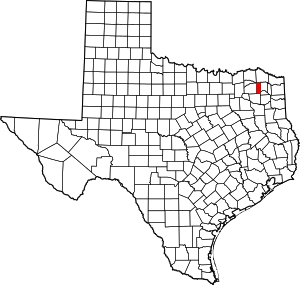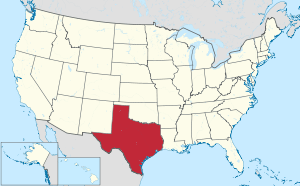Franklin County, Texas
Franklin County is a county located in the U.S. state of Texas. As of the 2010 census, its population was 10,605.[1] The county seat is Mount Vernon.[2]
Franklin County | |
|---|---|
.jpg) The Franklin County Courthouse in Mount Vernon in 2018 | |
 Location within the U.S. state of Texas | |
 Texas's location within the U.S. | |
| Coordinates: 33°11′N 95°13′W | |
| Country | |
| State | |
| Founded | March, 1875 |
| Seat | Mount Vernon |
| Largest town | Mount Vernon |
| Area | |
| • Total | 295 sq mi (760 km2) |
| • Land | 284 sq mi (740 km2) |
| • Water | 10 sq mi (30 km2) 3.5%% |
| Population (2010) | |
| • Total | 10,605 |
| • Density | 37/sq mi (14/km2) |
| Time zone | UTC−6 (Central) |
| • Summer (DST) | UTC−5 (CDT) |
| Congressional district | 4th |
| Website | www |
History
Franklin County was erected and established in 1875, four decades after the independence of Texas, from land ceded by neighboring Titus County.[3] Although the origin of the county's name is not recorded, it is generally believed to have been named after Judge Benjamin C. Franklin, the first appointed justice in the Republic of Texas.[4][5]
There are two historic properties listed on the National Register of Historic Places in Franklin County.
Franklin County was one of the last 30 prohibition,[6] or entirely dry, counties in the state of Texas.[7] Citizens of its county seat, Mount Vernon, voted to allow beer and wine sales, both on and off premises in May 2013.[2]
Geography
According to the U.S. Census Bureau, the county has a total area of 295 square miles (760 km2), of which 284 square miles (740 km2) is land and 10 square miles (26 km2) (3.5%) is water.[8]
Major highways
.svg.png)




Adjacent counties
- Red River County (north)
- Titus County (east)
- Camp County (southeast)
- Wood County (south)
- Hopkins County (west)
- Delta County (northwest)
Demographics
| Historical population | |||
|---|---|---|---|
| Census | Pop. | %± | |
| 1880 | 5,280 | — | |
| 1890 | 6,481 | 22.7% | |
| 1900 | 8,674 | 33.8% | |
| 1910 | 9,331 | 7.6% | |
| 1920 | 9,304 | −0.3% | |
| 1930 | 8,494 | −8.7% | |
| 1940 | 8,378 | −1.4% | |
| 1950 | 6,257 | −25.3% | |
| 1960 | 5,101 | −18.5% | |
| 1970 | 5,291 | 3.7% | |
| 1980 | 6,893 | 30.3% | |
| 1990 | 7,802 | 13.2% | |
| 2000 | 9,458 | 21.2% | |
| 2010 | 10,605 | 12.1% | |
| Est. 2019 | 10,725 | [9] | 1.1% |
| U.S. Decennial Census[10] 1850–2010[11] 2010–2014[1] | |||
As of the census[12] of 2000, there were 9,458 people, 3,754 households, and 2,732 families residing in the county. The population density was 33 people per square mile (13/km²). There were 5,132 housing units at an average density of 18 per square mile (7/km²). The racial makeup of the county was 89.19% White, 3.94% Black or African American, 0.63% Native American, 0.21% Asian, 5.14% from other races, and 0.88% from two or more races. 8.90% of the population were Hispanic or Latino of any race.
There were 3,754 households out of which 30.10% had children under the age of 18 living with them, 61.90% were married couples living together, 8.40% had a female householder with no husband present, and 27.20% were non-families. 24.60% of all households were made up of individuals and 12.80% had someone living alone who was 65 years of age or older. The average household size was 2.48 and the average family size was 2.95.
In the county, the population was spread out with 24.30% under the age of 18, 7.30% from 18 to 24, 24.80% from 25 to 44, 25.00% from 45 to 64, and 18.50% who were 65 years of age or older. The median age was 40 years. For every 100 females there were 94.30 males. For every 100 females age 18 and over, there were 92.80 males.
The median income for a household in the county was $31,955, and the median income for a family was $37,064. Males had a median income of $28,806 versus $19,361 for females. The per capita income for the county was $17,563. About 12.50% of families and 15.60% of the population were below the poverty line, including 21.20% of those under age 18 and 12.30% of those age 65 or over.
Politics
Franklin County is represented in the Texas House of Representatives by the Republican Gary Van Deaver of New Boston, Texas (Tx.HR Dist. 1). They are represented in the Texas Senate by Republican Bryan Hughes of Mineola, Texas (Tx. Sen. Dist. 1).[13] They are part of the Fourth Congressional District of Texas, represented by Republican U.S. Congressman John Ratcliffe[14] of Rockwall, Texas, from 2005 to 2020.
| Year | Republican | Democratic | Third parties |
|---|---|---|---|
| 2016 | 81.9% 3,585 | 15.2% 665 | 3.0% 130 |
| 2012 | 81.0% 3,446 | 17.6% 751 | 1.4% 60 |
| 2008 | 75.5% 3,392 | 23.1% 1,036 | 1.4% 63 |
| 2004 | 75.5% 3,185 | 24.0% 1,011 | 0.5% 21 |
| 2000 | 69.7% 2,420 | 29.3% 1,018 | 1.0% 34 |
| 1996 | 45.6% 1,575 | 43.0% 1,484 | 11.4% 393 |
| 1992 | 31.7% 1,058 | 40.0% 1,338 | 28.3% 946 |
| 1988 | 49.7% 1,439 | 50.2% 1,453 | 0.1% 4 |
| 1984 | 62.3% 1,836 | 37.5% 1,104 | 0.3% 8 |
| 1980 | 42.0% 1,105 | 56.5% 1,487 | 1.6% 41 |
| 1976 | 31.5% 758 | 68.1% 1,636 | 0.4% 10 |
| 1972 | 65.9% 1,059 | 34.0% 546 | 0.1% 2 |
| 1968 | 24.2% 481 | 50.3% 1,001 | 25.5% 507 |
| 1964 | 21.8% 424 | 78.2% 1,520 | |
| 1960 | 35.0% 620 | 64.7% 1,148 | 0.3% 6 |
| 1956 | 33.9% 556 | 65.9% 1,082 | 0.2% 3 |
| 1952 | 29.3% 564 | 70.6% 1,358 | 0.1% 1 |
| 1948 | 9.6% 146 | 80.9% 1,236 | 9.5% 145 |
| 1944 | 9.2% 147 | 83.5% 1,336 | 7.4% 118 |
| 1940 | 10.1% 183 | 89.8% 1,621 | 0.1% 2 |
| 1936 | 8.9% 90 | 91.0% 925 | 0.2% 2 |
| 1932 | 4.1% 56 | 95.8% 1,305 | 0.1% 1 |
| 1928 | 35.1% 386 | 64.9% 713 | |
| 1924 | 8.8% 118 | 86.6% 1,157 | 4.6% 61 |
| 1916 | 7.9% 62 | 86.8% 684 | 5.3% 42 |
| 1912 | 3.2% 19 | 94.9% 573 | 2.0% 12 |
Economy
According to a study[16] ordered by the Mount Vernon Economic Development Corporation in 2013, the local retail trade area population is 12,771 people. The county has 720 homes valued at $200,000 or more, 70 homes of $500,000 or more, and 72 homes valued at more than $1,000,000. Most of these homes are centered on Lake Cypress Springs, which was twice voted the Most Beautiful Lake in Texas by the readers of Dallas' "D" magazine (2005, 2010). The lake is located about 10 miles south of Mount Vernon. The EDC study determined the average sale price of lakefront property on Lake Cypress Springs (2012) was $484,000, with 91 percent of the 1,400 water-front homes being second residences. This concentration of second residences causes the population of the county to increase between 3,000 and 8,000 people on weekends and during holidays, according to estimates by the Franklin County Water District,[17] which oversees the lake and its visitors.
Education
The following school districts serve Franklin County:
- Mount Vernon ISD
- Rivercrest ISD (partly in Red River, Titus counties)
- Saltillo ISD (mostly in Hopkins County)
- Sulphur Bluff ISD (mostly in Hopkins County)
- Winnsboro ISD (mostly in Wood County, small portion in Hopkins County)
Communities
City
- Winnsboro (mostly in Wood County)
Town
- Mount Vernon (county seat)
Unincorporated communities
References
- "State & County QuickFacts". United States Census Bureau. Archived from the original on October 5, 2011. Retrieved December 16, 2013.
- "Find a County". National Association of Counties. Archived from the original on 2011-05-31. Retrieved 2011-06-07.
- Alvarez, Elizabeth Cruce (Nov 8, 2011). Texas Almanac 2012–2013. Texas A&M University Press. pp. Contents. Retrieved 17 November 2013.
- Gannett, Henry (1905). The Origin of Certain Place Names in the United States. Govt. Print. Off. pp. 131.
- W., KEMP, L. (12 June 2010). "FRANKLIN, BENJAMIN CROMWELL". Tshaonline.org. Retrieved 11 December 2017.
- "Archived copy". Archived from the original on 2014-05-16. Retrieved 2014-05-03.CS1 maint: archived copy as title (link)
- "Archived copy" (PDF). Archived from the original (PDF) on 2015-06-10. Retrieved 2013-11-14.CS1 maint: archived copy as title (link)
- "2010 Census Gazetteer Files". United States Census Bureau. August 22, 2012. Retrieved April 26, 2015.
- "Population and Housing Unit Estimates". United States Census Bureau. May 24, 2020. Retrieved May 27, 2020.
- "U.S. Decennial Census". United States Census Bureau. Retrieved April 26, 2015.
- "Texas Almanac: Population History of Counties from 1850–2010" (PDF). Texas Almanac. Retrieved April 26, 2015.
- "U.S. Census website". United States Census Bureau. Retrieved 2011-05-14.
- "Who Represents Me--Districts By County". Fyi.legis.state.tx.us. Retrieved 11 December 2017.
- "Archived copy". Archived from the original on 2013-12-07. Retrieved 2013-11-14.CS1 maint: archived copy as title (link)
- Leip, David. "Dave Leip's Atlas of U.S. Presidential Elections". uselectionatlas.org. Retrieved 11 December 2017.
- "Economic Development". Comvtx.com. Retrieved 11 December 2017.
- Archived 2014-01-10 at the Wayback Machine
